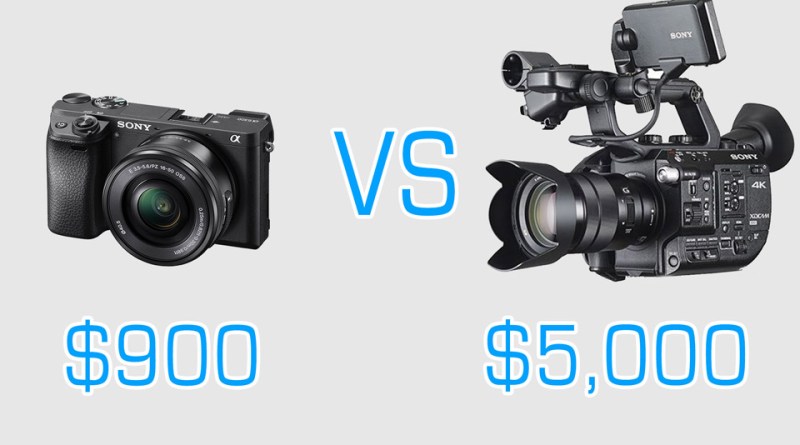Sony a6300 vs Sony FS5 : Camera Shootout
The Sony a6300 has been praised with glory from filmmakers across the world, but how does it stack up against a more professional camera like the Sony FS5?
We decided to compare them and see how close (or far) apart they are. In this comparison, we will compare few basics elements and see which camera excel in a specific area.
Before we start, let’s address a few things, we won’t talk about each camera features here as the list for the Sony FS5 is way longer than the one for the Sony a6300 since they are not meant to do the same “work”. We will only talk about usability and image quality, and in the end, that’s mostly what us filmmakers are after.
Setting wise, both cameras have been set to their highest settings and we will be using the same lens, the Sony SEL16F28.

Rolling Shutter
Sony cameras and rolling shutter… they all have it! We used to shoot a lot with DSLRs and Canon C100/C300 (still do), and I will always remember the first day I got my Sony a7s how noticeable the difference was. Anyhow, both cameras do have rolling shutter, the FS5 has less of it than the a6300 which makes it more usable straight out of the camera. Luckily, nowadays Premiere Pro has an amazing Rolling Shutter Repair tool which will allow you to fix the a6300 image, but some editors may be using different softwares or not be aware of it, so having a good image baked in is always preferred.

Dynamic Range
As for dynamic range, Sony claims that both cameras have 14-stops of dynamic range, which I believe is true for the FS5, in any situation you can always capture a lot of information. In the example below, we can see how the FS5 captured all the details in the sky.

On the other hand, we have the Sony a6300 here, and, even though you can see it does capture a great latitude, some highlights are blown. We didn’t do any specific dynamic range test, but according to a few sources, the a6300 would have around 11-stops rather than the 14-stops claimed by Sony.

If we look at each cameras RGB Parade, we can clearly see the dynamic range isn’t the same, although it is really good for a tiny mirrorless camera, there is still something happening in the highlights as highlighted in the image below.


Moiré
I won’t spend much time on moiré, both cameras handle moiré really well, for 99% of the time it won’t happen. So with both cameras, you can film, brick walls, chainlink fence, roofing tiles and funky shirts with ease. The 1% when it happens, it is usually something really linear with texture, like really deep building sidings, and you are filming it from far, in motion and you compress the footage. Outside of that, this is almost thing of the past!
Low Light
As for low lights, there is a clear difference between both cameras. I would encourage you to watch the video to really see it on your screen, but the a6300 has an image that holds up all the way to 25,600 ISO (the camera can’t go higher in s-log3) while the FS5 is pretty much unusable after 8,000 ISO. The Sony FS5 quickly lose image details and become muddy at 16,000 ISO while the Sony a6300 stay super sharp all the way to the end with a fine noise that makes all the shots usable.

Image Details
In the image sharpness and detail, the Sony a6300 shines again. Not that the FS5 image quality is bad per say, it is really good but we are pixel peeping here for the fun of it! The a6300 captures every little detail and texture in the image. In the example below, we can read the fine print easily compared to the Sony FS5 where it less clear and difficult to read.

Here we have another example, where we zoomed in in the corner and can see the difference here.
Slow Motion
For the slow motion, both cameras have to be set to 1080p. Again, we won’t compare the features as the FS5 can do 960fps when the a6300 is limited to 120fps. So we compared both at 120fps, and both cameras are pretty much identical at that settings. For both, the slow motion is smooth, it creates a good and detailed image without degradation. You can see it in our video at the top of the page.
Verdict
Both cameras are great, but it is impressive to see the image quality that comes out of the Sony a6300. On the image quality alone, the a6300 is ahead of the FS5, but when it comes to the colors and dynamic range, the FS5 delivers the goods. At the end of the day, both cameras have their place and use. The FS5 is a good all-around camera with a lot to offer, but you don’t always need all the features, and, many videographers out-there are using the a6300 as a primary camera (I surely do from time to time!) and shouldn’t be ashamed of it because, as we have seen it, this is a little powerhouse who is worthy of big productions quality.



Pingback: Canon C100 Mark I vs Sony FS5 : Camera Shootout - The Video Pro Guys